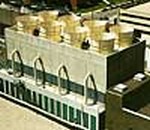Water cooling
Water cooling is a method used to remove excess heat from an object by circulating coolant through it. The mechanism by which water cooling removes heat is based on the principle of heat transfer, where heat energy is transferred from a higher temperature object (the device being cooled) to a lower temperature liquid (the coolant), which is then moved away from the object to dissipate the heat into the environment or to a secondary cooling device.
Overview[edit | edit source]
Water cooling is more efficient than air cooling due to water's higher specific heat capacity and thermal conductivity. This allows water cooling systems to manage the heat generated by devices more effectively, making it a popular choice for high-performance computing systems, such as gaming computers, data centers, and supercomputers, as well as in industrial applications and power plants.
Components[edit | edit source]
A typical water cooling system consists of several key components:
- Coolant Reservoir: A tank that holds the liquid coolant, usually water or a mixture of water and antifreeze.
- Pump: Circulates the coolant through the system.
- Water Blocks: Attached to the heat sources (e.g., CPU, GPU), these blocks transfer heat from the component to the coolant.
- Radiators: Where heat is transferred from the coolant to the air.
- Fans: Attached to radiators, they help dissipate heat away from the coolant.
- Tubing: Connects all components, allowing the coolant to flow through the system.
Advantages[edit | edit source]
Water cooling offers several advantages over traditional air cooling:
- Efficiency: Water has a higher thermal conductivity and specific heat capacity than air, making it more effective at removing heat.
- Noise Reduction: Water cooling systems can be quieter than air-cooled systems, as the major cooling action is performed by water flow rather than large, spinning fans.
- Aesthetics: Many water cooling setups, especially in custom PC builds, are designed to be visually appealing, with clear tubing, colored coolants, and LED lighting.
Disadvantages[edit | edit source]
Despite its benefits, water cooling also has some drawbacks:
- Complexity: Water cooling systems are more complex to install and maintain than air cooling systems.
- Cost: They are generally more expensive, both in terms of initial setup and maintenance.
- Risk of Leakage: Improper installation or failure of components can lead to leaks, potentially damaging electronic components.
Applications[edit | edit source]
Water cooling is used in various applications where efficient heat dissipation is critical:
- Computing: In personal computing, water cooling is often used in high-performance gaming PCs and workstations to cool CPUs, GPUs, and sometimes other components like RAM or SSDs.
- Industrial: In industrial settings, water cooling is used for machinery and processes that generate a lot of heat, such as in manufacturing or power generation.
- Automotive: Water cooling systems are essential in internal combustion engines and are being adapted for use in electric vehicles to cool battery packs and electric motors.
Conclusion[edit | edit source]
Water cooling is a highly efficient method for managing heat in various applications, from personal computers to industrial machinery. Despite its higher cost and complexity compared to air cooling, the benefits of improved cooling efficiency and noise reduction make it a preferred choice for many high-performance and high-heat scenarios.
Search WikiMD
Ad.Tired of being Overweight? Try W8MD's physician weight loss program.
Semaglutide (Ozempic / Wegovy and Tirzepatide (Mounjaro / Zepbound) available.
Advertise on WikiMD
|
WikiMD's Wellness Encyclopedia |
| Let Food Be Thy Medicine Medicine Thy Food - Hippocrates |
Translate this page: - East Asian
中文,
日本,
한국어,
South Asian
हिन्दी,
தமிழ்,
తెలుగు,
Urdu,
ಕನ್ನಡ,
Southeast Asian
Indonesian,
Vietnamese,
Thai,
မြန်မာဘာသာ,
বাংলা
European
español,
Deutsch,
français,
Greek,
português do Brasil,
polski,
română,
русский,
Nederlands,
norsk,
svenska,
suomi,
Italian
Middle Eastern & African
عربى,
Turkish,
Persian,
Hebrew,
Afrikaans,
isiZulu,
Kiswahili,
Other
Bulgarian,
Hungarian,
Czech,
Swedish,
മലയാളം,
मराठी,
ਪੰਜਾਬੀ,
ગુજરાતી,
Portuguese,
Ukrainian
Medical Disclaimer: WikiMD is not a substitute for professional medical advice. The information on WikiMD is provided as an information resource only, may be incorrect, outdated or misleading, and is not to be used or relied on for any diagnostic or treatment purposes. Please consult your health care provider before making any healthcare decisions or for guidance about a specific medical condition. WikiMD expressly disclaims responsibility, and shall have no liability, for any damages, loss, injury, or liability whatsoever suffered as a result of your reliance on the information contained in this site. By visiting this site you agree to the foregoing terms and conditions, which may from time to time be changed or supplemented by WikiMD. If you do not agree to the foregoing terms and conditions, you should not enter or use this site. See full disclaimer.
Credits:Most images are courtesy of Wikimedia commons, and templates, categories Wikipedia, licensed under CC BY SA or similar.
Contributors: Prab R. Tumpati, MD






